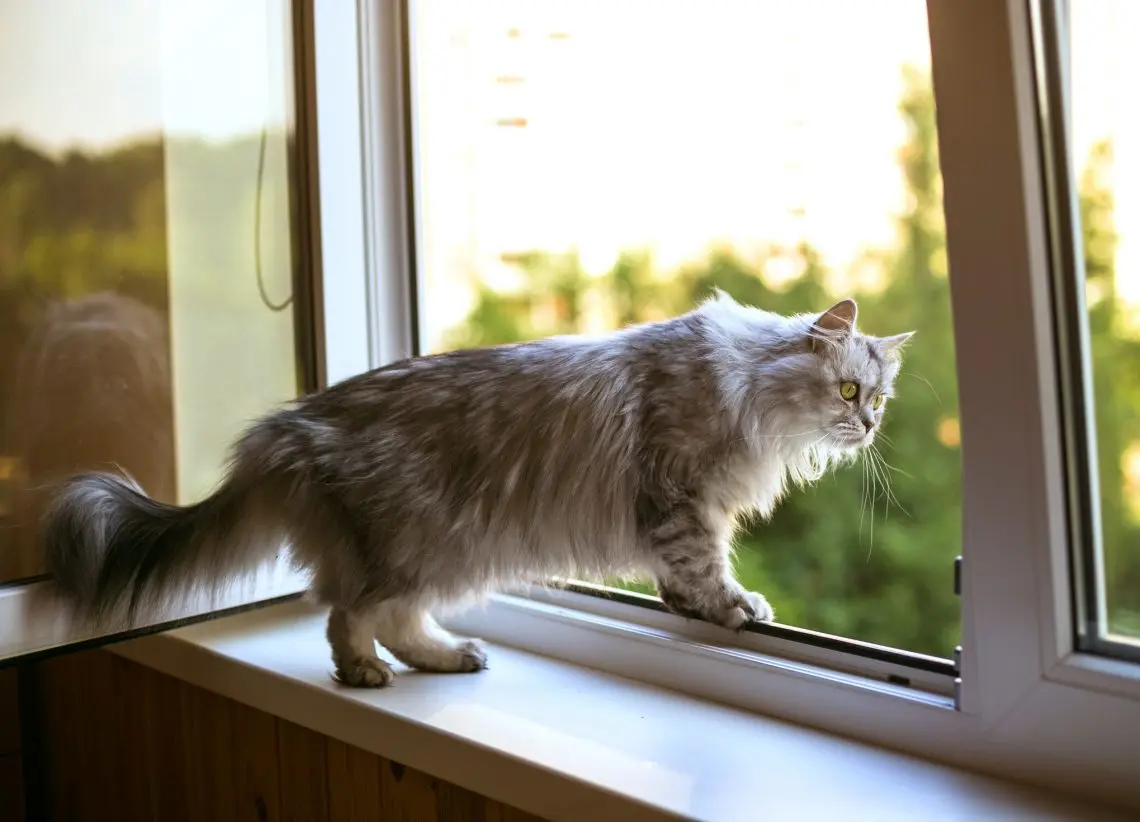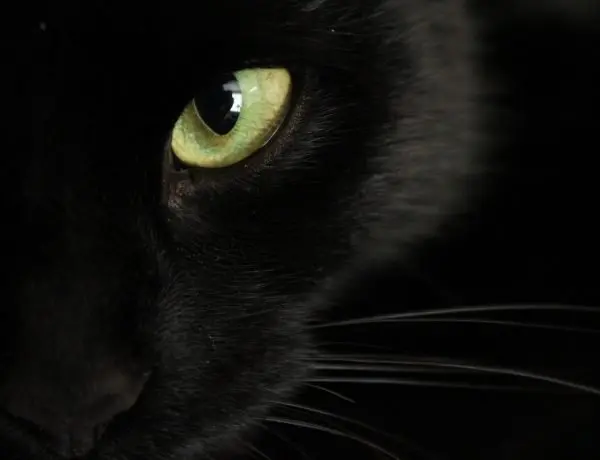If you are a new cat owner, your first goal should be to provide your furry friend with a loving environment and all the things it needs to have a long, quality life. One of the most significant decisions you’ll need to make is whether they should be kept indoors or free to wander outdoors.
It is strongly recommended that pet cats be kept indoors; they should only be outdoors when on a leash or in a safe outdoor enclosure, such as a catio. That is because there are many risks involved in allowing cats to roam outside, including exposure to diseases and parasites, unwanted litters, and threats to their safety and the wildlife around them.
Naturally, the health and safety of your feline should be one of your top priorities. While the idea of letting your cat channel its inner tiger as it prowls around the backyard might seem innocent enough, several problems can arise. Yes, your cat should have access to fresh air, but with a few precautionary measures. In the remainder of this article, we’ll discuss why it is recommended for cats to stay indoors and what you can do to keep them safe if you ever decide to allow them outdoors.
Table of Contents
Why Should Cats Stay Indoors?
Whether you are a first-time feline owner or have cared for cats before, it is easy to feel guilty keeping your companion locked inside. You might worry that being inside reduces the amount of fresh air and sunshine your cat experiences and limits their ability to put their natural instincts to use.
While there certainly are benefits to being in the outdoors for cats, there are many reasons why it’s best to keep your cat indoors:
Cats Are Domesticated Animals
There are dozens of domestic cat breeds that come in a range of sizes, colors, and personalities. Some look and act as though they are truly wild, but even with such diversity, these are all house cats, Felis catus.
No matter how many mice they catch or how aloof they might be, this is a species of cat that has been cohabitating with humans for thousands of years. They do retain some of their instincts, such as roaming at all hours of the night and trying to catch the pet fish, but humans have bred these felines for so long they are no longer genetically wild. Cats are simply used to a domesticated lifestyle, so any exposure to the wild may confuse them. (This National Geographic article explains just how domestication works.)
For example, when a house cat is put into a new situation, such as an unfamiliar environment, they become stressed. In addition, if your cat is outside chasing after a butterfly and gets distracted by a mouse in the grass, it may suddenly not remember which way is home.
So, while your feline might seem like a miniature leopard whose instincts can take over as soon as they step a paw outside, being a domestic cat means roaming free isn’t as safe as it might seem.
There Are Many Health Risks
When your friendly house cat is let outside, it can encounter not-so-friendly raccoons, squirrels, or feral cats. These animals may be carrying a disease, and if your curious kitty finds itself in a brawl with a carrier, it can get sick. Some potential illnesses your cat can contract include:
- Feline Aids (FIV)
- Feline Distemper
- Feline Infectious Peritonitis
- Feline Leukemia (FeLV)
- Rabies
- Upper Respiratory Infections
A few of the diseases your cat can contract can be treated, but others they must live with. Any of the health disorders can be severe or result in death. If your cat loves to explore the great outdoors, be sure to take them to the vet regularly, and have them tested for FeLV and FIV.
Not only does your kitty have the potential to pick up disease-causing bacteria and viruses, but it can also pick up unwanted hitchhikers—primarily parasites. Parasites your cat might become host to include:
- Fleas
- Intestinal Worms
- Mites
- Ringworm/Fungal Infections
- Ticks
Parasites can cause uncomfortable itching but can also grow to become a bigger problem if left unnoticed or untreated; parasites themselves can carry diseases such as Lyme disease. While these pests can usually be treated easily, the additional health issues they may bring can be more serious. Regardless, you are likely going to end up with a vet bill and one unhappy kitty.
Keeping your furry friend indoors or choosing to limit its access to the outdoors will help keep it much safer, and significantly reduces the risk of contracting illnesses or parasites.
There Are Safety Concerns
Health issues and safety go hand in hand, but there are many other risks an outdoor cat faces. The specific risks will vary depending on where you live; for example, there are more wild animals and fewer cars in a rural setting than in the city.
Major safety concerns for outdoor cats include:
- Animal Cruelty: Unfortunately, there some people in the world that abuse animals, including their own and other people’s. Even if you live in a safe neighborhood, there is the chance your cat runs into a not so kind person.
- Cars: While some people may believe their cat is smart enough to avoid traffic, that is not the case. Millions of cats are hit by vehicles annually; this is a devastating situation that can be easily avoided by keeping cats inside.
- Other Animals: No matter where you live, there are going to be other animals around. It might be wildlife, such as coyotes and cougars, or a neighbor’s aggressive dog. When outdoors, a cat risks being bitten, scratched, or killed by other animals. These animals aren’t hurting your pet because they are mean, though; they are merely defending their territory or are hungry. For example, a coyote doesn’t understand that it is okay to catch a wild rabbit but not your wandering cat.
- Lack of Defense: For cats who are declawed, the outside should be off-limits. Declawed cats, in particular, are unable to defend themselves if they have a run-in with another animal.
- Toxins and Poisons: Cats and all other animals frequently fall victim to chemicals put out by humans. Antifreeze tastes delicious to cats but is quite deadly, and your cat may think rodent bait is cat food or catch a rat that has been poisoned. You can find a full list of things hazardous to cats on Pet WebMD.
- Trees: Cats often find themselves climbing trees to escape a threat, out of curiosity, or while stalking a bird. Many cats can climb up the tree, but struggle or are afraid when it comes to climbing down. A cat stuck in a tree can suffer from dehydration if there for long enough. If your cat ends up in a tree or if you see any cat up in the branches, it crucial to take action. Rescue My Cat provides information on what to do when a cat is in a tree.
Unwanted Kittens
Kittens are adorable; they are a joy to watch as they learn to explore the world and grow with your family. If you’ve been wanting a kitten and finally receive one, it’s a dream come true. However, if you didn’t plan on having a kitten and suddenly find yourself with four or even more of these small, mewing balls of energy, it can quickly become a nightmare.
With that said, keeping unspayed and unneutered cats indoors is crucial. When unspayed cats are let outside, they may become pregnant by a neighbor’s cat or by a stray. If you have an unneutered male cat, he can impregnate a female, who may be without her own home; next thing you know, the poor kittens end up on the street or in shelters where they may be euthanized.
The Humane Society of the United States estimates there are between 30 and 40 million community cats in the U.S. The term “community cats” includes stray, abandoned, and feral cats. Each year 80% of the kittens born come from this population. By limiting your cat’s access to the outdoors, you can help reduce the number of cats living on the street, that are euthanized, or that become your responsibility.
Even if you never plan on letting your cat outdoors, getting your cat spayed or neutered has benefits including:
- Less Desire to Roam
- Reduced Risk of Cancer
- Increases Their Lifespan
If you have a cat but can’t afford to spay or neuter it, check out the SpayUSA program, which can help you find a free or low-cost clinic.
Note: While spaying or neutering your cat and limiting its outdoor access is a great way to prevent the growth of the community cat population, you can even do more. Alley Cat Allies is a program that provides information and resources to help spay and neuter cats without owners as well as information about owning a cat.
Environmental Impacts
As a pet owner, you are responsible for your cat’s care and what your cat does. Felines are predators; in the wild, they hunt and eat animals to survive. Even though you may serve your Russian blue its pâté on a silver platter, they are still carnivores with the instinct to hunt.
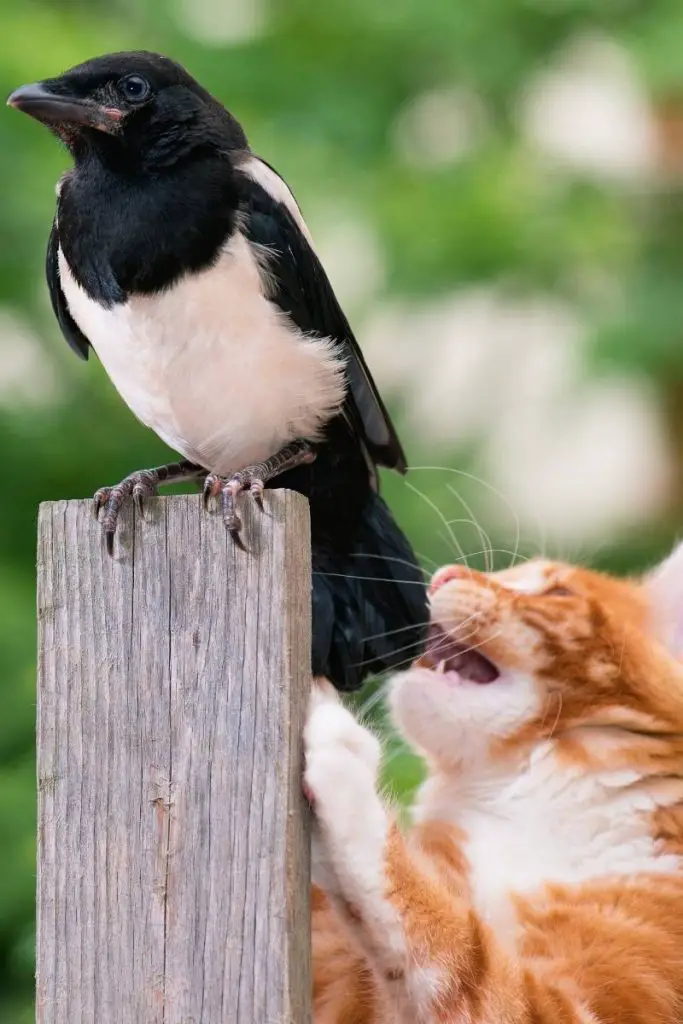
Unlike wild cats that hunt to survive, domestic cats hunt only because of biological urges. They may eat their prey, or they may leave it in your slipper.
When outside, your cat can be harmed by other animals, but it can also be deadly to the wildlife around it. According to the American Bird Conservancy, domestic cats kill roughly 2.4 billion birds each year.
Birds are not the only wildlife hunted by house cats. Other animals that could be hunted include:
- Rodents – squirrels, mice, rats
- Rabbits
- Amphibians and Reptiles – frogs, toads, salamanders, snakes, lizards
- Arthropods/”Bugs” – scorpions, cockroaches, grasshoppers, spiders
When an ecosystem is balanced, the number of predators is limited by the amount of prey and vice versa. While still part of an ecosystem, urban or rural, domestic cats are fed by humans, which makes the predator/prey ratio unbalanced. The result is wildlife populations can be decimated.
A study in the journal Nature Communications states that domestic cats are among the “100 worst non-native invasive species in the world” and have “contributed to multiple wildlife extinctions on islands.” In other words, while you can praise your cat when it catches a hardy spider in your home, if your cat is outside, it is in the spider’s home, and those spiders shouldn’t be needlessly killed. The Animal Emergency & Specialty Center provides information on how you and your cat can safely live alongside wildlife.
How Can Cats Go Outdoors?
The world outside your home is full of sights, sounds, and smells; it is both mentally and physically stimulating for your cat. So, just because your feline is “domestic” doesn’t mean it needs to be stuck inside, either.
There are a few ways to get the best of both worlds: the safety of being indoors and the benefits of being outdoors.
Use a Collar, Harness, and Leash
If you ever find yourself browsing the videos on YouTube, you might be convinced cats and leashes don’t mix, and sure, for some felines, it just isn’t going to happen. But don’t be too quick in ruling it out.
However, before you put the collar, harness, and leash on your feline and take a trip outside, make sure that it has some form of identification. You can ID your cat with a:
- Break-Away Collar + Tag: Unlike dog collars that buckle and can be troublesome to remove, cat collars are designed to come off easily. Cats like to traipse along fences, sneak through shrubs, and leap to great heights. While adventuring, collars can easily get caught on things. A cat break-away collar is built so that your kitty doesn’t choke in the event their collar snags on something.
- Microchip: If you are tired of replacing collars or just don’t like the jingle of dangling tags, having your cat microchipped is the way to go. A microchip is about the size of a grain of rice and is placed between your cat’s shoulder blades. If you are interested in having your cat microchipped, speak with your vet or local humane society.
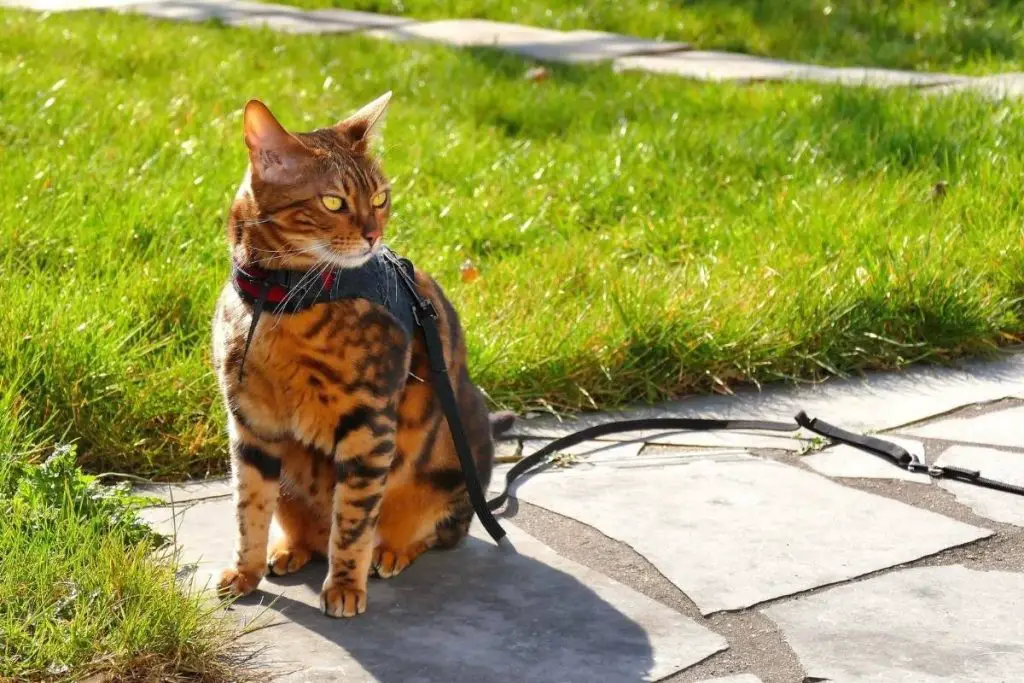
Once your cat is set with their collar or microchip, it’s time to pull out the harness and leash. Walking a cat on a harness is required. Since a cat collar breaks away, any pressure put on it from a leash will only pop it open, and away your kitty can go.
When it comes to cat harnesses, one size doesn’t fit all. Finding a harness that works for your cat might take a few tries. It is worth going into a pet store, with your cat if possible, and asking for some professional help in picking one out. If you prefer to do your shopping online, a few suggestions to try are:
- PetSafe Come with Me Kitty Harness and Bungee
- LeashPupteck Escape Proof Cat Harness with Leash
- Pupteck Adjustable Cat Harness with Leash
- Yizhi Miaow Escape Proof Cat Harness with Leash
When it comes to getting your cat actually walking with a harness and leash, it will require training. The key to success is to take it slow. Start by introducing your cat to its harness. Have it wear it around the house and give it treats when you put it on and take it off. Once your cat is comfortable with it on, it will make walking on a leash much easier. (The Anti-Cruelty Society has an additional guide to leash training your cat.)
If your cat is older, it might take longer for it to get used to its new harness and leash. Don’t give up. With some patience and time, you and your cat can roam the world together. If you recently became the owner of a kitten, get started with training early. The younger your kitten is when you begin training, the faster the process will be.
Once your cat is comfortable with its harness and leash, you can take it for a walk or hang out together in the yard. Buy a long lead, such as the 26-foot Cherpet cat leash, so you can safely let your cat get some fresh air without making them feel restricted. Be sure your cat has access to drinking water and is monitored while on its leash.
Invest in or Build a Catio
If your cat is just not happy with a harness and leash, another option is to install a safe outdoor enclosure. A catio, or cat patio, is an outdoor space for your cat to enjoy.
A catio provides your feline friend with the benefits of being outdoors but with the safety of being inside. They can be as simple as a lounging perch or as grand as a private cat oasis. Catio Spaces provides DIY catio plans so you can build one yourself, or hire a local carpenter.

You can attach a catio directly to your home so your cat can go in and out at its leisure or, if that’s not an option, buy a free-standing enclosure. A few popular kitty coops are:
- Hi Sui Portable Pop Up Tent
- Saninrayli Outdoor Shelter
- AmazonBasics 3-Tier Playpen
- PawHut Wooden Outdoor Cat House with Run
A free-standing cat house can be the perfect solution, but there are a few safety concerns that you should be aware of. Anytime your cat is ruling its roost, be sure to:
- Provide it with water. Any pet you own should always have access to fresh water. If you place food in with your cat, be sure to remove it when your cat is taken out. Pet food can attract wildlife.
- Monitor it. It is best to keep your cat company while outside. If your cat seems to be in any discomfort, be sure to bring them back inside.
- Check the weather. Even if the enclosure has a roof, cats that are not used to being outside should not be put in their cat house if the weather is too hot or cold or raining.
As long as you keep your cat’s health and safety in mind, a catio or enclosure can be an excellent option for access to nature.
Bring the Outside In
Of course, if you’d rather bring the outdoors to your cat, you can do that too! Bring the outside indoors by creating a cat garden. Both you and your feline will benefit from having indoor plants. Depending on the space you have, you can have a single plant or go all out. Some simple steps to designing your cat garden are:
- Find or make a fabulous pot.
- Put a handful of rocks in the bottom and cover with potting soil
- Plant some cat-friendly vegetation such as:
- Catnip
- Mint
- Rosemary
- Thyme
- Wheatgrass
- Place your cat garden near a window and water weekly.
- Your cat can start enjoying nibbling on the fresh greens!
A cat garden is a good start, but you can build a whole jungle. Purchase a few house plants in large pots, so they don’t get knocked over, and place them by a window. Then, hang a couple from the ceiling. Tuck a scratching post among them, and you’ve given your cat their own paradise.
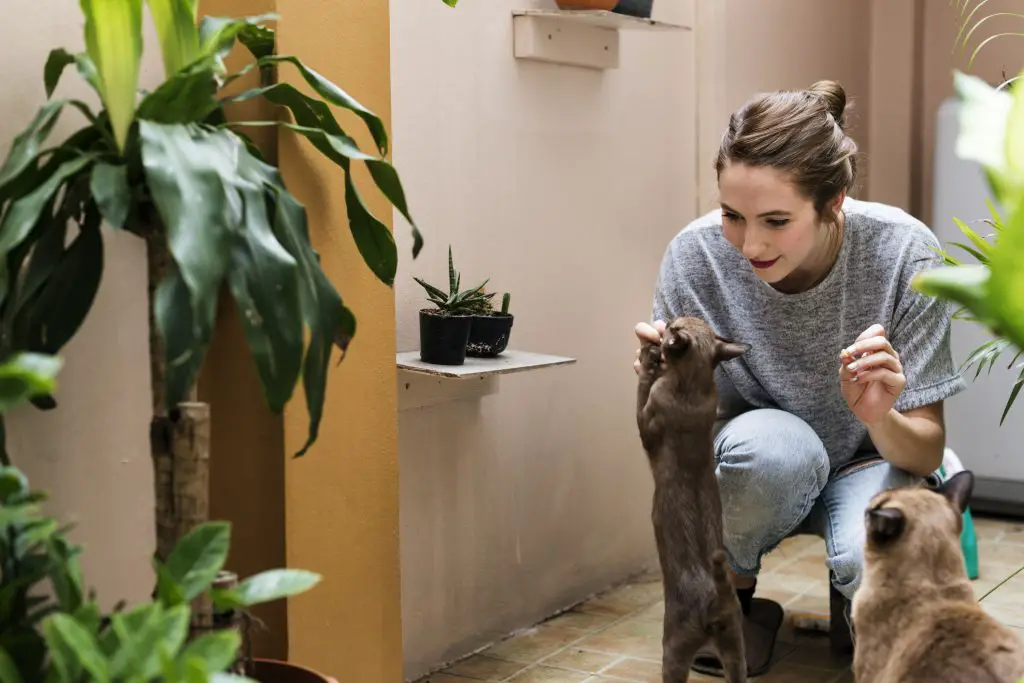
Not sure which plants are safe for your cat? A few plants that won’t make your kitty sick are:
- Baby Tears – Soleirolia soleirolii
- Banana – Musa sp.
- Spider Plant – Cholophytum sp.
- Areca Palm – Dypsis lutescens
- Peperomia – Peperomia sp.
Your cat will be thrilled to peer out from amongst the leaves and rub on the textured pots. While your kitty is in heaven, you can also reap the rewards of having plants in your home.
Encourage Natural Behavior Indoors
Being inside doesn’t have to be boring. Given the right environment, your cat can practice its hunting skills and perform natural cat instincts just as well indoors as they can outside.
Sometimes as owners, we get frustrated with certain instinctive “outside” behaviors like scratching or marking territory. Instead of getting mad, figure out why your cat is doing it and provide them with an alternative that works for both of you. Some behaviors can be altered with training, but others just need to be redirected.
When you keep your cat inside, it is essential to provide it with enrichment; what might seem like toys to us are actually vital tools that encourage natural behavior and mental stimulation. Any animal in captivity, your home, or the local zoo, needs enrichment. You can read more about enrichment and animal welfare on Wild Welfare.
Enrichment doesn’t need to be expensive; it can even be free. A few ideas for free or low-cost enrichment are:
- Bird Watching – Hang a bird feeder near a window; just make sure your kitty can see but can’t touch.
- Bring the Outside In – Bring rocks, sticks, or other nature items into your home for your cat to “play” with and smell.
- Build a Fort – Leave an empty cardboard box laying around. Your cat will know what to do.
- Clicker Training – It’s not just for dogs. You might be surprised at what your cat can do. Check out Adventure Cats to learn how to clicker train your cat.
- Kitty High Rise – Cats can be skittish and like to escape to high places, like trees, when they are afraid. Purchasing a cat condo, installing a sturdy shelf, or keeping the top of the bookcase clear are ways to provide your kitty with a safe place to climb. You can also check out Cat-O-Wall if you are looking for some great cat-friendly furniture for your home.
- Treat Hide-and-Seek – Stick some treats in an empty toilet paper tube and fill the ends with tissues or hide a few treats around the house. That will let your cat practice foraging and hunting.
Putting a little time and energy into providing your feline with enrichment will ensure being inside is just as exciting as being out. Plus, watching your cat sniff out hidden treats or cramming itself into a tiny box is fun enrichment for you, too!
Keeping your Cat Healthy, Safe, and Purring
Cats are animals and need to experience the stimulation of the outdoors; however, letting your cat have free rein of the neighborhood is not the way to go. You will get complaints when the neighbors find cat poop in their garden beds or when the local bird watcher notices a decline in the number of house finches.
Besides your cat causing some chaos for your neighbors and wildlife, you also put your cat at risk. You love your cat, and while letting them wander freely may seem ideal, they can get lost, hurt, sick, or worse.
By keeping your cat indoors, except when on a leash or in an outdoor enclosure, your cat will stay safe, you will have peace of mind, and you both can enjoy each other’s company for many years.

